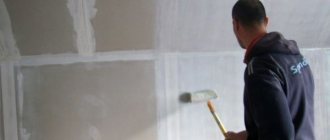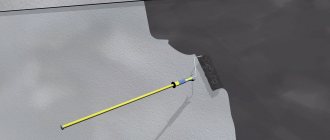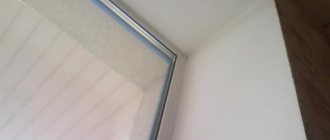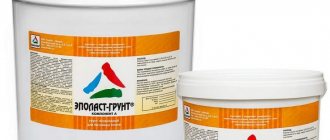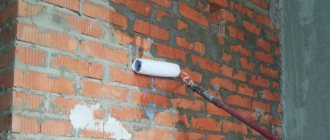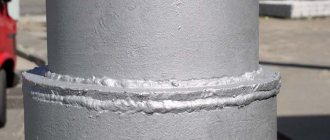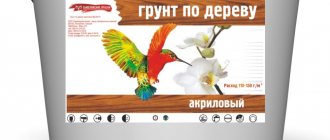Before painting a car, it is necessary to apply an epoxy primer, leveling primer or special sealants to the surface of its body. The listed compositions are types of primer for cars. In particular, epoxy primer for cars is distinguished by its dense structure and waterproof properties. Which synthetic paint is preferred for painting a vehicle and which primer will provide the best anti-corrosion protection? There is no clear answer to the questions asked.
Working moments
Many car enthusiasts are interested in how long it takes zinc primer to dry and whether it is possible to paint the vehicle immediately after it has dried. You will have to wait from 15 minutes to half an hour for the primer to dry, but you can start applying acrylic paint immediately.
Application of modern primers is not difficult. The spray gun will serve as an indispensable aid in this and will allow you to apply the primer by spraying. You can apply the primer yourself, and the main thing is to follow the sequence, because using a spray gun requires skill and compliance with all safety measures.
Before painting a car, calculating how long it will take to wait for the paint to dry, thinking about how to dilute it correctly and start using a spray gun, you need to protect your respiratory system.
It is recommended to use a respirator before performing work and use safety glasses and special gloves while the synthetic paint dries. It is prohibited to dilute paint and carry out painting work in a room that is not equipped with supply and exhaust ventilation and to paint surfaces without wearing protective equipment.
How to prime a car body with your own hands?
Priming a car with your own hands is much easier than painting, because it is quite difficult to make smudges on the ground. The priming technique is so simple that anyone can master it. To properly prime your car yourself, it is enough to familiarize yourself with the theory once. It is best to prime the car in a relatively clean, well-ventilated area with a minimum of dust. If we are talking about local priming, then you should cover the parts that will not be primed with special paper (in extreme cases, newspapers) and masking tape. Before applying primer, you should prepare a tool such as a primer sprayer in advance.
Features of selection and application
If you are wondering which primer you can choose for a car and you are interested in how long it can be stored at home, then carefully study the videos presented on thematic sites.
Priming the underbody and body of the car before painting it prevents the occurrence of rust and corrosion on the surface of these parts, after which reliable adhesion and rapid “adhesion” of acrylic paint to the surface being treated is ensured. Today the market is overflowing with various products for body repair, including two-component putties, which can be epoxy or polyester.
Before using putty, prepare the surface (matt it and clean it from corrosion). At the beginning of mixing the putty, a pink hardener from a tube is added to it; its proportion should be 1:20. After this, the resulting mass must be diluted with a small spatula until a homogeneous consistency appears.
Preparation: treatment with putty
Putty is an essential part of the work, a preparation that is performed before painting a car with synthetic paint and immediately before priming its parts.
Correct application of putty helps eliminate scratches and dents on the vehicle body; after the putty is completed, they become almost invisible. The first layer of putty must be applied with slight pressure on the spatula, which allows you to evenly fill all the unevenness and scratches on the surface.
How long will it take for the putty to dry completely? Polyester putties are sometimes called “high-speed” putties, because they will take from 15 to 20 minutes to dry on plastic and metal. Epoxy putties, which are used in conjunction with a hardener, dry completely in 30 minutes at an air temperature of +20 °C.
If the room is cool, then it is permissible to use a ceramic heater or a household hair dryer to speed up the drying process of the putty on the surface. After the putty has dried, you can begin sanding the surface, applying primers using a spray gun, which prevent rust and are used after puttying, and painting the underbody and body of the car.
The putty is used by vehicle drivers and car service employees immediately before applying the primer mixture to the car body and is used to fill uneven areas and restore the shape of damaged metal and plastic parts.
Applying acrylic primer to a car
Acrylic primer is applied to:
- fill pores;
- create a protective layer;
- slightly level the surface, giving it greater smoothness;
- create a base for the paint.
The thickness of acrylic primer application can range from 50 to more than 100 microns.
Depending on the number of elements, the primer can be one-component or two-component .
The first is applied in a thin layer and is mainly used for applying to new parts before painting. This ensures improved adhesion and rust protection.
A two-component primer is more versatile and suitable for any work on the body.
It is necessary to strictly observe the proportions when diluting the primer
In addition, only thinner is added to a one-component primer (approximately 1 part thinner to 5 parts primer). No hardener is added. In a two-component mixture, you need to first add a hardener and then a thinner (usually 1 part hardener and 1 thinner to 4 parts primer).
Important!
If the package says 4+1, then 4 parts of primer require 1 part of hardener. If there is an inscription 5+1, then, accordingly, for 5 parts of primer you will need 1 part of the hardener.
How to dilute automotive acrylic primer
These mixtures contain many elements. And it is from the final composition of a particular primer from a particular manufacturer that you need to select a substance that can subsequently be used to dilute the primer. There are only two best options:
- Water - but only if it is one of the components of the acrylic primer itself. The packaging should then bear the inscription “water-acrylic”. If the old primer has hardened to a solid mass, then the water needs to be heated almost to boiling water.
- Special acrylic thinners are an excellent option for thinning. It is recommended to select them of the same brand as the soil itself.
Acrylic thinner
Important!
It is not recommended to dilute this type of primer with solvents marked 647 and 650 - they are not suitable for acrylic. In extreme cases, solvent 646 can be used.
Most often it is recommended to maintain the following proportion - 4:1 with the addition of a thinner. For more detailed information, please refer to the instructions on the product label.
For example, the label of Novol Protect 300 4+1 MS primer says that for 4 parts primer you need to take 1 part hardener and 25%-35% thinner.
It is important to understand that acrylic fillers remain in an unchanged state for 30-60 minutes, which is how long after mixing they will be ready for use. This time must be taken into account when stirring the primer and applying it.
The resulting composition is applied using a spray gun. But before you fill the mixture into the device, it must be filtered (for example, through nylon or a double layer of gauze). This is done in order to cut off all large fractions that could clog the pneumatic sprayer.
How to apply filler - tips and tricks
The following sequence of actions must be followed:
- If small smudges or other minor defects have formed, then after drying they can be easily leveled by sanding.
- The primer must be applied in a thin, even layer.
- In order to get the desired effect, apply 2 or 3 layers of acrylic primer. Between each application you need to wait about 20-40 minutes. At this time, evaporation of particles occurs. But you should be very careful, since the required evaporation period depends to a large extent on the ambient temperature, as well as on the thickness of the applied layer, the composition of the primer and its proportions, the type of surface being treated, and many other factors.
- To achieve a uniform, smooth effect with a minimum amount of smudges formed, it is necessary to cover the surface using cross movements.
- It is the pneumatic sprayer that allows you to achieve a more even and uniform surface, compared to using a brush.
- After the last acrylic layer of primer has been applied, it is necessary to wait for 20-40 minutes first, and then increase the temperature in the room where the car is parked. This will speed up the drying time of the soil and its hardening.
- At the final stage, after complete drying, the surface is sanded. Sanding can be done mechanically or manually, and can also be done dry or wet.
How to apply primer - tips and tricks
Primers are mainly needed to enhance adhesion between the substrate and the paint. The principle of working with it is somewhat simpler:
- Before opening the primer, you need to shake it well.
- You should try to make the applied layer as thin as possible, applying a minimum amount of composition. For work, you can use a brush or swab.
- After applying the layer and before painting, you need to wait 5-10 minutes (check the packaging for the exact time) until the primer dries completely.
- Before applying paint, you need to make sure that the primer layer is smooth, even and free of any contamination.
- If the surface has pores or minimal roughness, a second coat of primer can be applied in the same way as the first.
Adding Plasticizer to Primer
It is possible (and even recommended) to add a plasticizer to the acrylic filler primer that will be applied to plastic and other synthetic surfaces of the body - this is a special additive that will make the material more elastic and help avoid cracking of the paint even when the painted element is deformed. In addition, it neutralizes the impact of high and low temperatures on the material - the paintwork will shrink and expand as the temperature changes along with the element itself.
Plasticizer additive Novol Plus 770
The amount of plasticizer added to the primer can usually be deducted from the product label. Usually this is 10-30% of the finished primer mixture, then a hardener and thinner are added. The stiffer the plastic, the less plasticizer needs to be added.
After adding the plasticizer, the primer does not need to be infused or other manipulations carried out with it, but it is worth noting that the drying time of the applied layers will be increased by approximately 2 times.
Tintable primers
Fillers (secondary primer) can also be tinted. This is done by introducing acrylic paints into the composition - approximately 10-15% of the volume. The result is a tone that is as close as possible to the factory or re-applied enamel. This is done in order to:
- When a chip formed, this place was not visible, that is, the primer in the resulting chip will not differ from the tone of the top layer of paint.
- In this case, painting and repairs could be postponed until a time convenient for the owner, rather than being done urgently.
Tips for doing the job
On the Internet you can find videos and step-by-step photographs that clearly demonstrate the entire process of priming a car and applying paint yourself. In this case, a spray gun is used - a special tool used for painting various surfaces by spraying a dye.
A primer intended for processing metal and plastic, removing traces of rust, and providing anti-corrosion protection, differs in its composition and technical characteristics from primer compositions that are used for plastic or wood.
Automotive primer dries in a short period of time; it must be diluted with a solvent and hardener. It is better to adhere to the proportions indicated on the can and not try to independently choose a different ratio of components. The primer prepares the surface of metal or plastic for further painting using a spray gun and ensures high adhesion of the coating. In rare cases, the primer composition can be applied to the surface in an absolutely even layer and then wait until shrinkage occurs - a natural phenomenon that car enthusiasts encounter before painting their vehicle.
When a primer applied with a spray gun to the surface of a metal or plastic dries and begins to exhibit its rust-repellent properties, unevenness and roughness appear. After completing the work, you can compensate for these defects and make them invisible on metal and plastic by using sandpaper. You can find out how long it will take to wait for the applied composition to completely dry in the instructions for use, which are always included with the purchased primer mixture.
If the body or underbody of the vehicle is heavily corroded, then it makes sense to abandon the use of a modifier primer, since it is impossible to determine by eye how deep the rust has penetrated into the metal and then make sure that you have applied a sufficient amount of primer mixture that can transform the rust into persistent inert layer. Primers with anti-corrosion properties are never used for processing wooden parts.
Types of soils for cars
Before you start applying primer with your own hands to the surface of the car body, you need to choose exactly the composition that is suitable for your purposes.
You should know that there are a large number of similar products on the market. Before starting work, you should familiarize yourself with how many types there are and what each of them is intended for.
So, the following types of primer compositions for cars are distinguished:
- acrylic;
- acid;
- epoxy.
Acrylic car primer MIXON 5+1 white 1 l
Acrylic type is the most common. This is an almost universal primer for a car, which is applied to the surface of the body before painting for:
- leveling the surface and filling micro-irregularities;
- improving adhesion;
- anti-corrosion protection;
- guarantees that the paint will last a long time and with high quality.
Acid primer is a means of chemical protection of the car body from moisture and salts. It forms a thin film that prevents corrosion. It must be remembered that acid primer is a means of primary treatment of the car before applying a secondary layer. Paint is not applied to it under any circumstances. It needs to be applied in a thin layer, with filler placed on top, and only then paint.
It is strictly forbidden to use an acid composition together with polyester putty and epoxy primer. In this case, the effect of the acidic layer is simply neutralized, and it loses all its protective properties.
Acid primer Body 960 for cars
Epoxy primer is a substance that protects the car body from corrosion and external mechanical influences. This occurs due to the fact that a durable film is formed on the surface of the car body, onto which a paint layer can be applied. Experts say that epoxy film does not allow water to pass through, is heat-resistant and durable. They also emphasize the high environmental friendliness of this product - it is made from natural materials.
The downside to epoxy is the amount of time it takes to dry. Epoxy primer takes more than 12 hours to dry - this product is clearly not suitable for quick car repairs.
Epoxy primer for cars
Another type of classification is based on how many components a substance contains. There are 2 types of primers for cars:
- one-component;
- two-component.
One-component materials are ready for use - they do not require preliminary preparation before starting work, and they do not need to be diluted with anything. Before starting work, two-component materials must be diluted with a hardener and solvent, after which they can be applied.
Primer mixtures can be sold in metal cans or aerosol cans. Only one-component substances are sold in cans that can be used immediately. They are very convenient to use, but have extremely low productivity. If there is a large amount of work to be done, the aerosol is not suitable for you - it is intended for treating local areas of the car body.
Two-component acrylic fill primer


